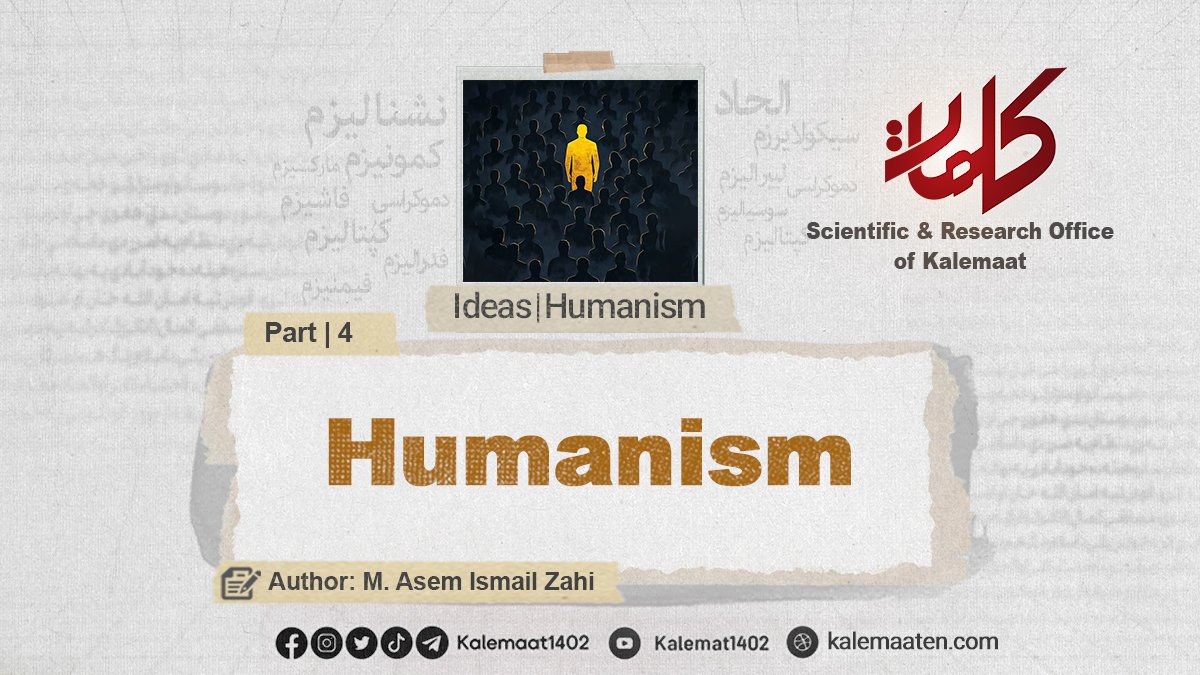Author: M. Asem Ismail Zahi
Humanism (Part Four)
Humanistic Discourses
Based on historical periods, scholars speak of four major humanistic discourses, each of which can be subdivided into smaller forms of humanism. These four major discourses are: Classical Humanism, Renaissance Humanism, Enlightenment Humanism, and 20th-Century Humanism. Each of these will be briefly discussed below.
It is also possible to define humanism by linking it to a specific philosopher or philosophical movement—for example, Marxist Humanism, Heideggerian Humanism, Existentialist Humanism, and so on.
In another classification, humanism is divided into two general categories:
-
Anthropocentric (Human-Centered) Humanism:
In this humanistic approach, religion is considered destructive and rejected, or it is seen as a narcotic from which humans can be freed. This form of humanism is itself divided into two types:
a. Deistic Humanism: The impossibility of communication with God;
b. Atheistic Humanism: An extreme, atheistic mode of thought that denies the existence of God.
-
Religious or Theocentric Humanism:
In this humanistic approach, humanism is limited within the framework of religion and addresses only one aspect of the many dimensions of human life.[1]
Classical Humanism
With the Sophists—and later with Socrates, Plato, and Aristotle—the trajectory of thought shifted from ontology, cosmology, and natural philosophy toward anthropology. The human being became the central philosophical question. Prior to this era, the primary question was: What is nature? But after this shift, the fundamental question became: What is man? In fact, the focal point of intellectual inquiry changed and came to revolve around the human being, his motives, and his interests.
During this period, even ethics came under the scrutiny of reason and was examined critically using rational and scientific methods. The famous statement of Protagoras—”Man is the measure of all things”—belongs to this era. The peak of this intellectual movement appears in the philosophy of Socrates, to the extent that the only world he truly recognized was the world of the human being, and all of his investigations were confined to this realm. [2]
Renaissance Humanism
Renaissance humanism emerged in Italy during the second half of the 14th century with the aim of studying the works of ancient Greek and Roman writers. This movement was primarily philosophical and literary. Its followers sought to revive the literary and artistic heritage of classical antiquity.
People of the Renaissance era had grown weary of religious doctrines, and at the same time they sought an alternative worldview to replace them. The Church had deprived them of intellectual and ideological freedom, insisting on the fixed and unchangeable nature of human destiny—an idea that in practice brought a kind of enslavement upon human beings.
Turning to the thinkers of ancient Greece, who approached everything through reason, Renaissance scholars decided to establish a new worldview based on rationality, which came to be known as humanism. Among the most prominent humanists of this era are Dante, Petrarch, Pico della Mirandola, Erasmus, and Boccaccio.
Pico della Mirandola (an Italian Renaissance writer), in his famous Oration on the Dignity of Man, quotes God as saying: “O man, I have given you no fixed place, no specific appearance, and no special privileges, so that you may determine your own nature freely and without constraint, solely through the power of choice which I have granted you. I have placed you at the center of the world so that from that vantage point you may better observe all that exists. I have not made you heavenly or earthly, mortal or immortal, so that like a free and absolute craftsman, you may shape yourself into whatever form you choose.” [3]
Enlightenment Humanism
Unlike Renaissance humanism—which was more negative in its orientation—Enlightenment humanism possessed a more affirmative character. During the Enlightenment, humanism took on a distinctly philosophical form. The human being came to be understood as a biological entity endowed with reason. Humanity became the foundation and center of the universe, and rational thought emerged as the primary tool for exercising technical control over reality.
Denis Diderot argued that only the existence of the human being gives meaning to the existence of all other things, for the human is the only beginning and end to which everything must be related.
20th-Century Humanism
In the 20th century, at least four major forms of humanism emerged: Marxist Humanism, Pragmatist Humanism, Existentialist Humanism, and Personalist Humanism. Each of these discourses has its own independent interpretation.
Overall, the humanistic movements of the 20th century are generally non-religious and aligned with secularism. In most cases, humanism refers to a non-theistic worldview centered on human agency, relying on science and reason rather than divine revelation from a supernatural source to understand the world.
Humanists tend to advocate for human rights, freedom of expression, progressive policies, and democracy. Those who hold a humanistic worldview believe that religion is not a prerequisite for morality, and they object to excessive religious interference in education and government.
Humanism and Religion
From a religious perspective, there are two types of humanism: anthropocentric (human-centered) humanism and theocentric (God-centered) humanism.
In human-centered humanism, the human being is regarded as the center of the universe—the creator of everything, even the creator of his own god. In the second type, theocentric humanism, God is the axis of existence and the human being lives within this divine framework. However, the individual does not rely on God; rather, the emphasis is placed on human capability and autonomy. Some thinkers even describe humanism as faith in the true God, meaning faith in the human being himself. According to them, although an inner voice suggests the existence of God, because humans cannot see Him, they should refrain from making assertions about Him. What is present and visible is the human being, and thus, in their view, man is his own god, and the number of gods corresponds to the number of human beings.
Despite their opposition to medieval theology and asceticism, humanists were not inherently anti-religious or anti-Christian. Their interest in defending human value and freedom often led them to discussions about God, divine power, and doctrinal issues concerning the soul, its immortality, and its freedom—topics that were usually treated in traditional medieval fashion. However, in humanism, these concepts acquired new meanings, because humanists attributed the capacity for innovation and initiative to human beings and defended this power even within the sphere of religion.
Gianozzo Manetti, in his work On the Great Men of Humanism, writes that the Holy Scriptures are not merely a declaration for otherworldly salvation but also a guide for earthly well-being. According to Manetti, religion is the trust in the value of human action, its success, and its reward in the afterlife. Like Lorenzo Valla and many others, he saw the fundamental role of religion as supporting humans in their legal lives and political activities.
Humanists believed that the absence of commitment to a set of religious principles would cause the foundations of the social order to collapse. The religious views within humanism were deeply imbued with the spirit of tolerance. The concepts of tolerance and forbearance—shaped largely by the religious wars of the 16th and 17th centuries—refer to the possibility of peaceful coexistence among different religious beliefs, which remain distinct and cannot be merged into a single unified creed. For this reason, humanists derived their tolerant outlook from the idea of a fundamental unity among all religious faiths and the possibility of universal religious peace.
Moreover, Pico della Mirandola, inspired by the idea of tolerance, became the herald of a new vision of peace that sought to harmonize all the religions and philosophical traditions of the world. His Oration on the Dignity of Man proposed a universal plan for peace through reconciliation between Platonic and Aristotelian thought. Pico also advocated harmony among these two philosophies, other ancient schools of thought, the Kabbalah (Jewish mysticism), magic, patristics (teachings of the early Church Fathers), and scholasticism. His proposal ultimately aimed at harmonizing philosophy with Christianity and divine revelation.
Continues…
Previous Part
References:
- Heidegger, Martin. Letter on Humanism, p. 67.
Translated by: Ebrahim Alipour. (Master’s Thesis).
Tehran, June 2002.
- Heidegger, Martin. Letter on Humanism, p. 77.
Translated by: Ebrahim Alipour. (Master’s Thesis).
Tehran, June 2002.
- Sane’pour, Maryam. God and Religion in a Humanistic Approach, p. 43.
Tehran: Institute for Contemporary Culture and Thought, 2002.
- Sane’pour, Maryam. God and Religion in a Humanistic Approach, p. 40.
Tehran: Institute for Contemporary Culture and Thought, 2002.



